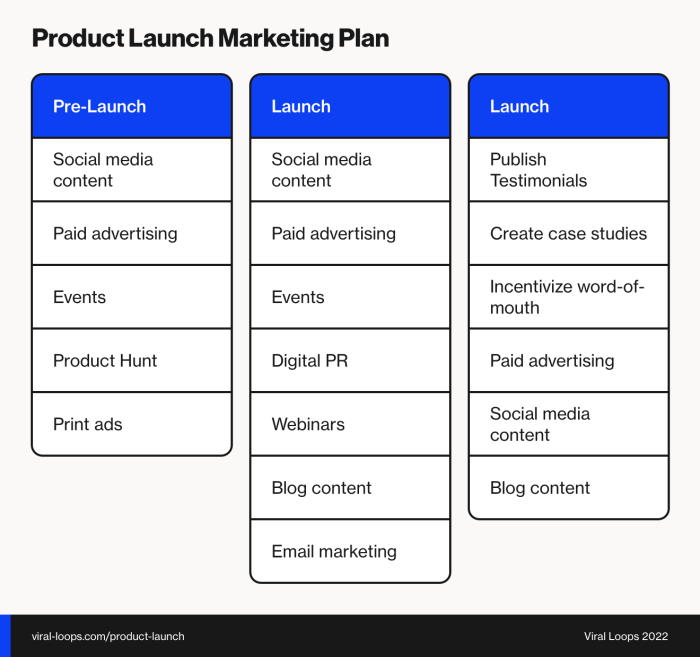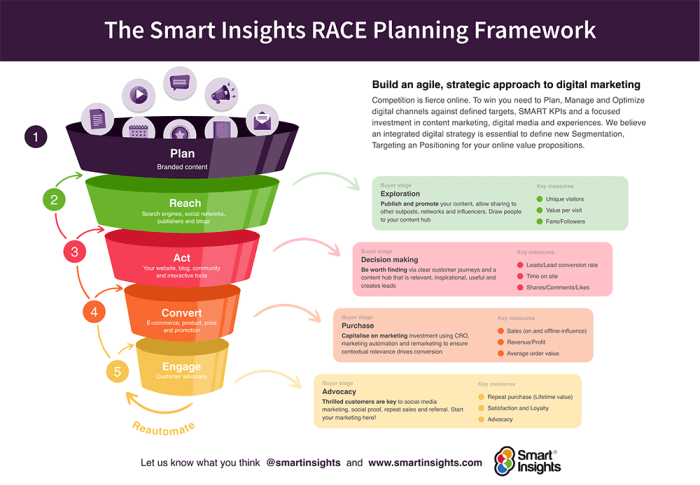Developing a Product Launch Plan: Unleashing Success dives into the art of crafting a strategic roadmap for launching products that captivate audiences and drive success. It’s time to unleash your product’s full potential with a well-thought-out plan!
Get ready to embark on a journey that will transform your product launch game and set you apart from the competition. Let’s dive into the nitty-gritty details of creating a winning plan that will elevate your product to new heights.
Research and Analysis
Market research plays a crucial role in developing a successful product launch plan. By gathering valuable insights about the target market, consumer preferences, and industry trends, companies can make informed decisions that maximize the chances of a successful product launch.
Importance of Market Research
Market research helps companies understand their target audience, including their needs, preferences, and behaviors. By conducting thorough market research, businesses can identify market gaps, assess demand for their product, and tailor their marketing strategies to effectively reach their target customers.
- Surveys and Questionnaires: Gathering direct feedback from potential customers through surveys and questionnaires can provide valuable insights into consumer preferences and buying behaviors.
- Focus Groups: Conducting focus groups allows companies to have in-depth discussions with a small group of individuals to understand their perceptions, opinions, and attitudes towards a product or service.
- Data Analysis: Utilizing data analytics tools to analyze market trends, consumer behavior, and competitive landscape can help businesses make data-driven decisions.
Competitor Analysis Influence
Analyzing competitors is essential in shaping the product launch strategy. By understanding the strengths and weaknesses of competitors, companies can position their product effectively in the market and differentiate themselves from the competition.
- Identifying Competitive Advantages: By analyzing competitors, companies can identify areas where they can offer unique features or benefits that set them apart from competitors.
- Pricing Strategy: Understanding how competitors price their products can help companies determine the optimal pricing strategy for their own product launch.
- Marketing Insights: Studying competitors’ marketing strategies and messaging can provide valuable insights into effective marketing tactics and communication channels.
Setting Objectives and Goals
Setting clear objectives and goals is crucial for the success of a product launch plan. It provides a roadmap for the team to follow and ensures that everyone is working towards a common purpose.
Setting SMART Goals
When setting goals for a product launch, it is essential to make sure they are SMART:
- Specific: Clearly define what you want to achieve with the launch. For example, increase sales by X%.
- Measurable: Set metrics that will allow you to track progress and determine if the goal has been met.
- Achievable: Ensure that the goal is realistic and within reach based on resources and capabilities.
- Relevant: Align the goal with the overall objectives of the launch and the business.
- Time-bound: Establish a deadline for achieving the goal to create a sense of urgency and focus.
Defining Target Metrics
Defining target metrics is essential for measuring the success of a launch plan. By determining specific metrics related to sales, customer engagement, website traffic, or social media interactions, you can evaluate the effectiveness of the launch strategy. This data provides valuable insights into what worked well and areas that may need improvement for future launches.
Aligning Launch Objectives with Business Goals
Aligning launch objectives with overall business goals ensures that the product launch contributes to the long-term success of the company. When launch objectives are in sync with business goals, it helps to prioritize activities that drive growth, increase profitability, and strengthen the brand’s position in the market. This alignment also fosters a cohesive approach across different departments, creating a unified effort towards achieving organizational success.
Target Audience Identification

Identifying the target audience for a product launch is crucial for creating a successful marketing strategy. By understanding who your customers are, you can tailor your messaging, positioning, and product features to meet their specific needs and preferences.
Methods for Segmenting and Profiling Target Customers, Developing a Product Launch Plan
- Demographic Segmentation: This involves dividing the target audience based on factors such as age, gender, income, education, and occupation.
- Psychographic Segmentation: This focuses on understanding the lifestyle, values, interests, and personality traits of the target customers.
- Behavioral Segmentation: This categorizes customers based on their purchasing behavior, usage patterns, brand loyalty, and decision-making processes.
Understanding Customer Needs for Product Positioning
- Conduct Surveys and Interviews: Engage with potential customers to gather feedback on their pain points, preferences, and expectations.
- Monitor Social Media and Online Reviews: Analyze customer sentiment and feedback to identify common themes and areas for improvement.
- Competitor Analysis: Study how competitors are positioning their products and identify gaps in the market where your product can excel.
Product Positioning and Messaging
When it comes to defining a unique selling proposition for a product, the key is to identify what sets your product apart from the competition. This could be a specific feature, a benefit that solves a problem for your target audience, or even the overall brand image that differentiates you in the market.
Creating Compelling Messaging
To create messaging that resonates with the target audience, it’s essential to understand their pain points, desires, and preferences. Crafting a message that speaks directly to their needs and emotions can make a significant impact. Use language that they relate to and highlight how your product can improve their lives or solve their problems.
Successful Product Positioning Strategies
- Apple’s “Think Different” campaign positioned their products as innovative and unique, appealing to creative individuals who wanted to stand out.
- Nike’s “Just Do It” messaging focused on empowerment and motivation, resonating with athletes and individuals looking to push their limits.
- Coca-Cola’s “Open Happiness” campaign positioned their beverages as a source of joy and connection, appealing to a wide audience looking for moments of happiness.
Budgeting and Resource Allocation
When it comes to launching a product, budgeting and resource allocation play a crucial role in determining the success of your campaign. Allocating budget effectively and optimizing resources can make a significant impact on the outcome of your product launch. Here are some key factors to consider and tips to keep in mind:
Factors to Consider when Allocating Budget
- Identify your key marketing channels: Determine which channels will be most effective in reaching your target audience and allocate budget accordingly.
- Consider the cost of production: Factor in the costs of manufacturing, packaging, and shipping when setting your budget.
- Account for advertising and promotion: Allocate a portion of your budget for advertising, PR, and other promotional activities to create buzz around your product.
- Include room for unexpected expenses: Leave some wiggle room in your budget to account for any unforeseen costs that may arise during the launch process.
Importance of Optimizing Resources
Optimizing resources is essential for maximizing the impact of your product launch. By making the most of your available resources, you can ensure that your campaign is both cost-effective and efficient.
Tips for Cost-Effective Marketing Strategies
- Utilize social media: Leverage platforms like Instagram, Facebook, and Twitter to reach a wide audience without breaking the bank.
- Collaborate with influencers: Partnering with influencers in your industry can help amplify your message and reach a larger audience organically.
- Host virtual events: Organize webinars, live streams, or virtual product launches to engage with your audience in a cost-effective way.
- Focus on content marketing: Create valuable and informative content that resonates with your target audience to drive organic traffic and interest in your product.
Marketing and Promotion Strategies
When it comes to marketing and promoting a new product, there are various channels and tactics that can be utilized to create buzz and generate interest among the target audience.
Social Media Marketing
Social media platforms such as Instagram, Facebook, Twitter, and LinkedIn can be powerful tools for reaching a wide audience and engaging with potential customers. By creating engaging content, running targeted ads, and collaborating with influencers, companies can effectively promote their new product and drive sales.
Email Marketing
Email marketing remains a valuable tool for product launches, allowing companies to directly reach out to their audience with personalized messages, special offers, and product updates. Building an email list and sending out strategic campaigns can help build excitement and anticipation for the new product.
Public Relations (PR)
Public relations play a crucial role in shaping the public perception of a new product. By securing media coverage, organizing press events, and leveraging industry influencers, companies can create a buzz around the product launch and establish credibility in the market.
Examples of Successful Product Launch Campaigns
One notable example is Apple’s launch of the iPhone, which involved a combination of secretive teaser campaigns, live events, and media coverage to create hype and anticipation among consumers. Another successful campaign is the launch of Tesla’s Model 3, which utilized social media, live streams, and pre-order incentives to drive excitement and generate record-breaking sales.
Sales and Distribution Plan
Developing a solid sales and distribution plan is crucial for the success of a product launch. It involves creating a strategy to effectively sell the product and choosing the right channels to distribute it.
Sales Strategy Development
- Identify target markets and segments to focus sales efforts.
- Create a pricing strategy that aligns with the product positioning and target audience.
- Train sales teams on product features, benefits, and unique selling points.
- Establish clear sales goals and metrics to track performance.
Choosing Distribution Channels
- Consider the nature of the product and where the target audience is most likely to make purchases.
- Evaluate the reach and effectiveness of different distribution channels such as retail stores, online platforms, or direct sales.
- Build relationships with distributors, retailers, or online marketplaces to ensure product availability and visibility.
Effective Sales and Distribution Strategies
- Apple’s launch of the iPhone through exclusive partnerships with carriers helped create hype and drive sales.
- Coca-Cola’s distribution strategy of targeting key locations like supermarkets, convenience stores, and vending machines ensures maximum reach and availability.
- Tesla’s direct-to-consumer model bypasses traditional dealerships, allowing for better control over the sales process and customer experience.
Timeline and Milestones: Developing A Product Launch Plan

To ensure a successful product launch, creating a well-defined timeline with key milestones is crucial. This helps in organizing tasks, setting priorities, and tracking progress throughout the launch phase.
Setting Key Milestones
- Identify major tasks and activities required for the product launch.
- Establish deadlines for each milestone to stay on track.
- Assign responsibilities to team members to ensure timely completion.
- Regularly review and adjust the timeline as needed based on progress.
Importance of Setting Deadlines
Setting deadlines creates a sense of urgency and accountability among team members, ensuring that tasks are completed on time.
- Deadlines help in prioritizing tasks and focusing on critical activities.
- Tracking progress against milestones allows for better resource allocation and risk management.
Managing Unexpected Delays
- Anticipate potential challenges and have contingency plans in place.
- Communicate openly with team members and stakeholders about delays and seek solutions collaboratively.
- Reassess the timeline and adjust deadlines if needed to accommodate unexpected delays.